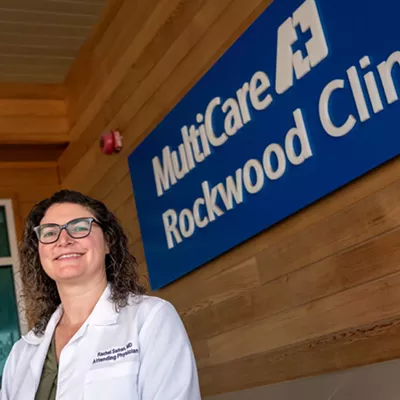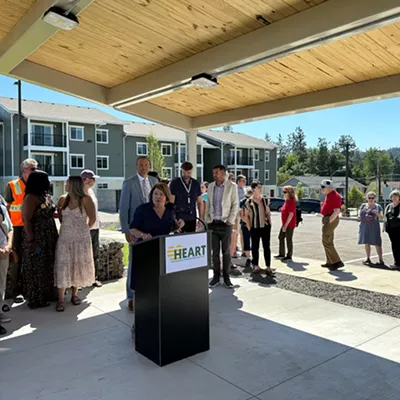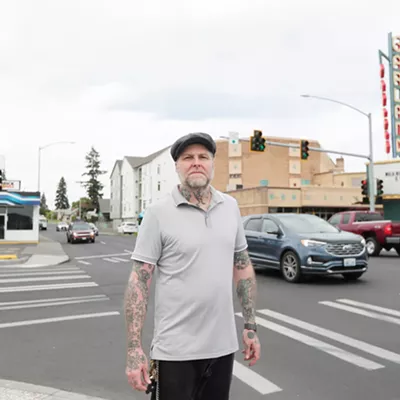Ariving West on Highway 12 in southeastern Washington, it's easy to imagine you've just driven onto the canvas of an Andrew Wyeth painting. This is classic east-of-the-mountains beauty with century-old barns tucked among the gradual, tawny hills. As you approach the Walla Walla valley, there is little to suggest that you have entered a region that's home to a soaring wine industry. But take a closer look and you'll spot the telltale patches of grapevines growing among the wheat.
Best known for sweet onions, the massacre of Christian missionaries and its funny name, Walla Walla is making a serious statement in the wine industry. As a new winery opens about every 13 days in Washington state, Walla Walla seems to be setting the pace for growth. Two years ago there were nine wineries in the valley; today there are about 30. And in the past year, vineyard acreage has doubled from 450 acres to more than 1,000.
"It's pretty exciting," says Steve Burns, director of the Washington Wine Commission. "Walla Walla is echoing what's happening in the entire industry with explosive growth and also accelerated raising of the bar in quality."
The Walla Walla Valley is one of four Washington state appellations (federally recognized wine growing regions), the others being Puget Sound, Yakima Valley and the Columbia Valley. It has the advantage of about two more hours of sunlight a day during the growing season than the wine regions of California, and it shares the same northerly latitude, between the 46th and 48th parallels, as the famed French regions of Burgundy and Bordeaux.
Long before there were magazines like Wine Spectator and Wine Enthusiast, the potential for growing grapes was evident here. An editorial from the April 1, 1871, Walla Walla Statesman commented, "Grape culture is fast becoming an important feature with our husbandmen. It is now an established fact that grapes of all kinds do as well here as in any part of the habitable globe."
One hundred thirty years later, this city of 29,000 seems to be getting its 15 minutes of fame. Pick up any wine, or even travel magazine, and chances are they're talking about this arid, 280-square-mile region and the wine it's producing. A recent issue of Wine Spectator says Walla Walla has become Washington's trendiest wine region, and touted its wineries as "producing six of the 11 best red wines in Washington state." In just the past month, no less than three national magazines have run feature articles on the region. The October, 2000, issue of Wine Enthusiast magazine says of Leonetti Cellars, "If his 1998 Merlot isn't the best $50 merlot in the world, then I don't know what is." Even Men's Journal jumped on the bandwagon in its September issue with an article titled "Walla Walla Mon Amour," which was more about Washington red wines in general, but reportedly used Walla Walla in the title because it's really fun to say.
"I really can't keep track of all the growth and changes anymore," confesses Myles Anderson, a principal of the Walla Walla Vintners and director of the recently founded Wine Institute at Walla Walla Community College. Anderson says he has a waiting list of 30 to 40 people waiting to take courses like "Establishing a Walla Walla Vinifera Vineyard" and "Irrigating Vinifera Grapes in the Walla Walla Valley." He says he's surprised by the popularity of the courses and has a curriculum in place for an associates degree in fermentation science.
Many of his students are third or fourth generation wheat farmers who have some free parcels with water where they can plant some grapes and show a little better profit than wheat, which is barely paying for its cost to produce. Grapes are good business at the local farm supply store where they can hardly keep vineyard supplies in stock. Says an employee at L & amp; G Ranch Supply, "[It] seems like everyone is pulling up wheat and putting in grapes."
So, will the home town of NFL quarterback Drew Bledsoe become home to the next Napa Valley? "I think that kind of shortchanges what is possible in Walla Walla," says Steve Burns, who feels wine should be about making a connection to a place and its people. "What's interesting about Walla Walla and Washington state is that it's not California. Robert Mondavi is just not standing in his tasting room in Napa Valley, and neither are 90 percent of the winemakers. That's not the case here."
Burns says he often hears from visitors how refreshing it is to tour these wineries because they're small and personal, and when you can talk to the winemaker himself while tasting his merlot, it's easier to make that connection.
This area's brief wine history can be traced to the mid-1970s when Rick Small started making wine with his friend Gary Figgins who went commercial with Leonetti Cellars, releasing his first vintage cabernet sauvignon in 1978.
Rick started Woodward Canyon soon after with his first release in 1981. Next on the scene was Baker Ferguson who started the L'Ecole No. 41 winery out of an abandoned three-story schoolhouse in 1983. One year later, Eric and Janet Rindal started Waterbrook, completing the initial foursome.
After a 1994 article in Wine Spectator claimed Leonetti was "making the best merlots in the United States," Walla Walla was officially on the map.
Currently, the cult-like demand for Leonetti's wine requires about a three-year wait just to get on the mailing list. Those lucky enough to get their hands on the precious few available bottles tend to hang onto them with a Bobby Knight-like grip.
What is it about a region that attracts prestigious winemakers -- who could go anywhere in the world to make wine -- and choose to do so in Walla Walla?
"Some of the best ground in the world is laying right here in the Walla Walla Valley," says Christophe Baron, the winemaker for Cayuse Vineyards. Growing up in Champagne, France, where he says his family has been making wine since the 17th century, Baron is steeped in the traditions and techniques of the wine industry. He studied viticulture (the cultivation of grapes and grapevines) and enology (the study of wine and winemaking) in Champagne and Burgundy, spent a year working at Waterbrook Winery for a year and spent time in Romania, New Zealand and Australia making wine. In 1996, he bought some land in the Walla Walla Valley, a one-time riverbed covered in grapefruit-sized rocks which reminded him of the same rocky soil he knew in southern France. A year later he chiseled through the stone to plant syrah, cabernet sauvignon and chardonnay grapes.
Driving with Baron to visit his vineyards, the high energy 30-year-old talks passionately, pausing only to take drinks from a bottle of Perrier, about wine and what attracts him to this area.
"It's very dynamic what's going on in the valley," he says through a thick French accent. "There is so much potential here. It's wide open because there is no history. It is still in the infancy stage. In France, you're dictated by government or tradition, there is a lack of spiciness. But here we are writing our own history -- we are building our own reputation. If you want to be part of the Walla Walla Valley, you better know right away that you have to make very, very good wine. The standard is high."
Pulling up to the vineyard, he gets out of the truck and walks down a row of trellised vines. Meticulously pruning perfect looking grape bunches and dropping them to the ground, he bends down and tastes the dirt to stress the importance of soil: "I like to be able to taste the terroir in wine."
Terroir, he explains, is a French word that literally means soil, but the broader definition includes all the conditions the winemaker cannot change that make a piece of land unique: like soil, climate and geography. Along with what he calls the "pure spirit of the people," he says, "that's the beauty of this area."
With consumer demand for red wines at an all-time high, Washington state leads the nation in sales percentage increase at 41 percent over the last 12 months. It's second only in the world to Australia, which has had a 42 percent increase in sales the past year.
What this has meant to Walla Walla is evident when you stroll through a vibrant downtown that five years ago saw empty storefronts and for lease signs. Today it's dotted with stylish tasting rooms, a requisite Starbucks, a new bookstore and new restaurants. The historic Whitman Hotel was purchased and completely renovated as well as a new upscale restaurant, the Whitehouse Crawford, whose impressive wine list promotes local wine.
With predictions of a 100,000-case-a-year winery locating within five years (most local wineries produce about 5,000 cases), the challenge will be to balance the growth while maintaining the off-the-interstate charm of the area. So far, wine snobbery has not hit Walla Walla. All tastings are still free, and the wine community remains welcoming and inclusive to newcomers.
Says Baron in a flurry of Wallas, "I think Walla Walla will always be Walla Walla. We don't want to be the next Napa Valley, we want to be Walla Walla."














